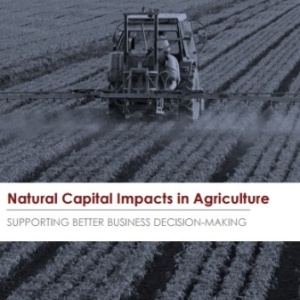
This report by the Food and Agriculture Organisation of the United Nations (FAO) aims to inform decision-making that focuses on reducing impacts on natural capital.
It begins by stating that there is a worrying disconnect in many countries between the retail price of food and the true cost of its production. As a consequence, food produced at great environmental cost in the form of greenhouse gas emissions, water pollution, air pollution, and habitat destruction, can appear to be cheaper than more sustainably produced alternatives.
Based on the report, FAO aims to develop a “Food and Beverage Sector Guide of the Natural Capital Protocol”. It is hoped that these publications will encourage businesses to use a monetary approach and integrate natural capital costs into mainstream business decision-making and operations.
The report builds on knowledge gained through the Food Wastage Footprint: Full-Cost Accounting a report produced by Trucost (a consultancy working to provide data and insight to help its clients understand the economic consequences of natural capital dependency) and FAO in 2014. Data has been primarily sourced from FAO and Trucost, with other relevant datasets coming from lifecycle analysis databases such as Agri-footprint.
And their new report delivers:
- A global, commodity-based “materiality” approach to assess the natural capital impacts caused by the production of four crops – maize, rice, soybean and wheat – and four livestock commodities – beef (from cattle), milk (from cattle), pork and poultry.
- A set of four case studies focusing on different agri-commodities, exploring the trade-offs that exist between adopting different farming practices. These studies include:
- Beef: Holistic grazing management vs. conventional cattle grazing in Brazil
- Rice: System of rice intensification (SRI) vs. conventional rice farming in India
- Soy: Organic farming vs. conventional soybean farming in the USA
- Wheat: Organic farming vs. conventional wheat farming in Germany
The main findings from this phase of work are:
- The natural capital costs associated with crop production in this study represent nearly USD 1.15 trillion, over 170 percent of its production value, whereas livestock production in this study produces natural capital costs of over USD 1.18 trillion, 134 percent of its production value.
- Farming practices have been analyzed in over 40 countries, which contribute to about 80% of global production for each commodity, and the highest combined operational and supply chain costs of natural capital impacts in this study have been attributed to beef production in Brazil (USD 596 million) and the USA (USD 280 million), as well as pork production in China (USD 327 million).
- On average, 64 percent of the impacts of livestock production can be attributed to operational activities taking place on the farm. For example, the conversion of natural ecosystems to pastureland for beef production in Brazil, which results in a natural capital cost of over USD 473 million, is the largest single impact in the study.
- Supply chain impacts can represent a significant source of the costs of agricultural production, as is the case for pork production in China, which generates air emissions, uses water, and converts land that have a natural capital cost of over USD 118 million. This is due in part to the production of animal feed.
- On average, 77 percent of the natural capital costs of crop production occur on the farm. The highest natural capital costs of crop production in this study can be attributed to maize farming in China, followed by rice farming in China and India.
- India generates the greatest natural capital costs associated with rice farming. The costs total over USD 80 million and are due to the impact of water pollution, land use change and water consumption.
- In extreme cases, the overuse of fertilizers can be the source of significant natural capital impacts, as is the case for wheat farming in Germany. The natural capital cost of fertilizer leaching into waterways is responsible for 95 percent of its total impact, or USD 55 million.
For more on findings from the various case studies see link to full report below:
Read the full report here and see further information on Natural Capital Accounting on the FAO website here.
You can find more information in our categories on natural capital, and decision making tools. You can also see results of a general search on cost-accounting.







Post a new comment »